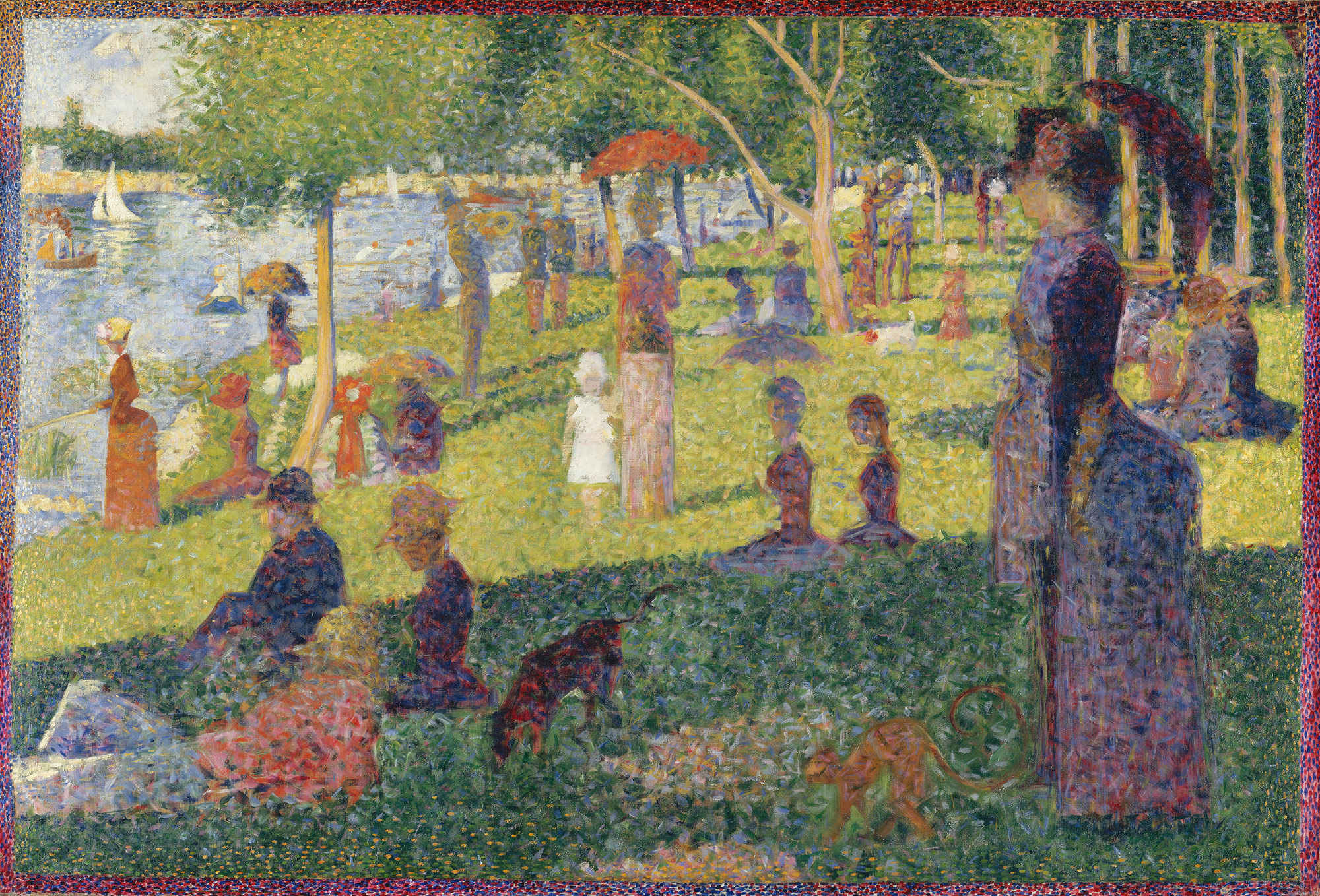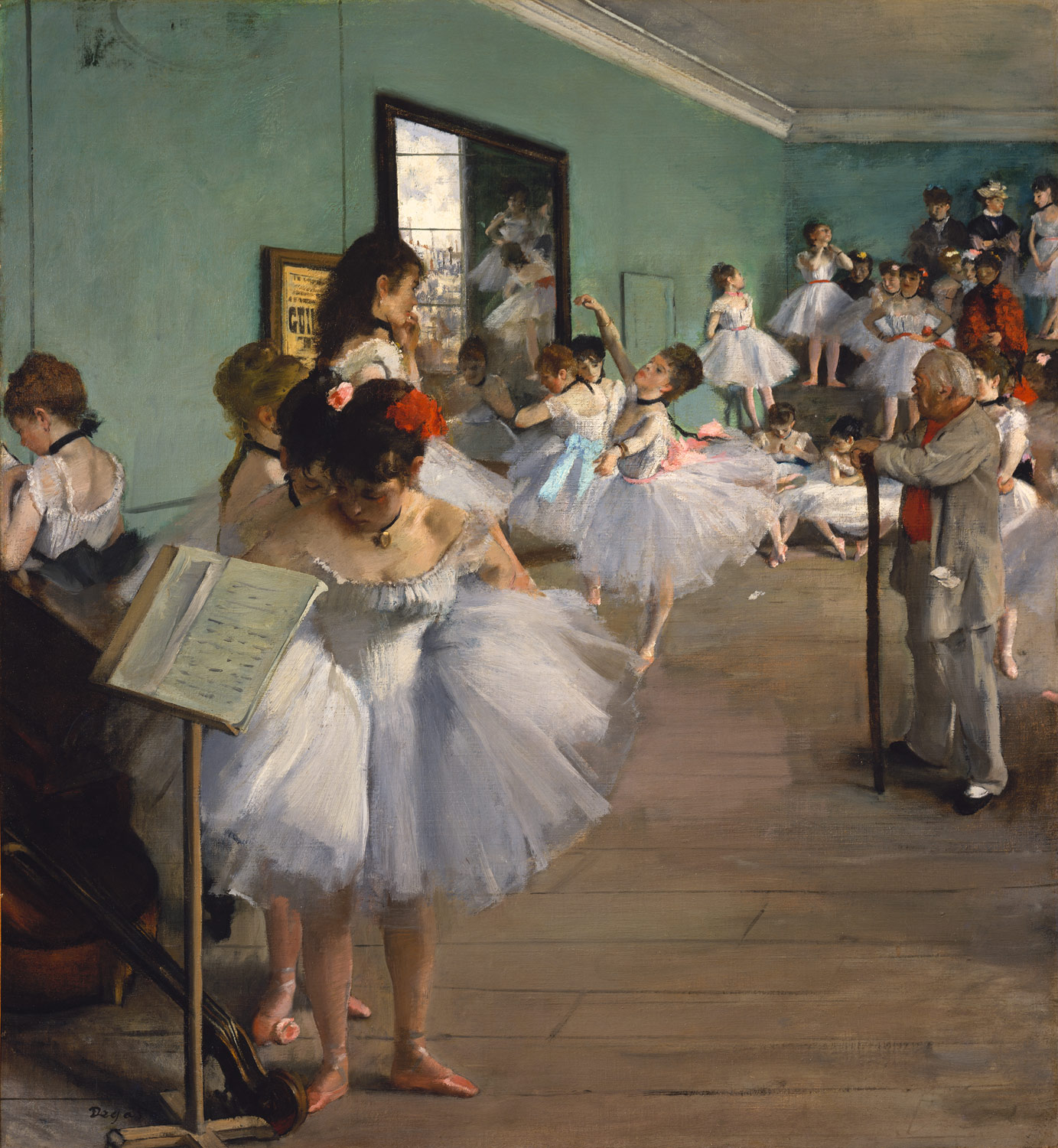Georges Seurat (1859 – 1891) was a post-impressionist artist
who painted Saturday on the Island of La
Grande Jatte from 1884 to 1886. In this painting, and many others, he
paints with dots, rather than strokes, which creates an effect called optic
mixing. For instance, in the grass, he does not just use shades of green.
Instead, he adds in yellows and pinks and blues. Upon close examination, we as
the viewer can see these dots and extreme detail that Seurat utilizes, but from
afar our eyes see one solid color. Seurat is described as a post-impressionist,
because unlike his impressionist predecessors, he is not concerned with
relaying his own sensations or emotions. Seurat paints what he sees in a more
realistic naturalistic fashion and is not as interested in the emotional or
spiritual dimensions of life. Through the comparison of A Saturday on the Island of La Grande Jatte to his previous works
and other artists, we can see Seurat’s precise technique and style. He puts
time and effort into his artwork which correlates to his desire to portray visual
order and harmony. Rather than being didactic or displaying the emotional dynamics
of nature and people, he is concerned with accurately depicting what he sees
and allowing his subject to be believable.
Georges Seurat, A
Study for A Saturday on the Island of La
Grande Jatte, 1884, oil on canvas, 27 3/4 x 41 in. (70.5 x 104.1 cm)
This painting is the focus of this curation. It represents
Seurat’s interest in visual order and harmony. It’s naturalistic in a sense,
yet so orderly that the trees don’t look very real upon close examination. This
painting is similar to impressionism as it is a flattened, everyday scene of
leisure. Many of the people in this painting are static and not dynamic and
have a somewhat Egyptian look to them in side profile. It adds a scientific and
rational heft to impressionism.
Georges Seurat, A Sunday on the Island of La Grande Jatte,
1884 – 1886, oil on canvas,
81 3/4 × 121 1/4 in. (207.5 × 308.1 cm)
81 3/4 × 121 1/4 in. (207.5 × 308.1 cm)
This painting
is Seurat’s work after a Study on A
Sunday on the Island of La Grande Jatte. Seurat worked on this painting for
multiple years as he continually went back to it to alter and amend it. He was
so concerned with portraying what he was actually seeing that he took three
years to perfect it. In this painting, Seurat’s dots that he paints with are
more condensed and less brushy. The figures are more solidified and unified,
which shows his emphasis on visual order and harmony rather than the emotional
and spiritual aspect.
Claude Monet, Garden at Sainte-Adresse, 1867, Oil on canvas, 98.1 x 129.9 cm
Monet studied Japanese prints and modeled his paintings after the
spacing out of horizon and landscape of the prints. The boats in this painting
could possibly be bringing these Japanese prints Monet studied. Monet is
representing the life of modern middle-class life but is representing this idea
of the middle-class rather than painting what he merely sees. He is using his
knowledge of the Japanese prints to then translate that to this painting of two
wealthy people near a garden and being influenced by modern commerce. This is
different than Seurat’s painting as he is representing what it life as a
modern-middle class person is and he is using influences from Japanese
printmaking. Similar to Seurat, this is a flattened, everyday scene of leisure,
and he uses vibrant colors to portray modern life.
Paul Gauguin, Spirit of the Dead Watching, 1892, oil
on canvas,
116.05 cm × 134.62 cm (45.6 in × 53 in)
116.05 cm × 134.62 cm (45.6 in × 53 in)
Gauguin is fascinated by the
exotic and is very much interested in primitivism. He has this false,
idealistic idea that women of other cultures are more sexually intuitive and
have a higher sex drive than the average European woman. Rather than being
interested in the detail of what they look like, Gauguin is interested in what
is happening in the spiritual existence. He sees modern life as bad and
detrimental to mankind as it is alienating people and creating an inauthentic
world. Seurat, on the other hand, is interested in the modern life and
represents social harmony and order in that particular setting. He paints what
he sees, whereas Gauguin paints the spiritual. While Seurat’s paintings
represent social harmony and visual order, Gaugin’s are disharmonious, and we
can interpret them as disorderly in a moral sense.
Claude Monet, Sunrise, 1872, oil on canvas, 48 cm x 63
cm (18.9 in x 24.8 in)
Similar to Seurat, Monet is painting a scene, a moment in
time. Monet is concerned with painting the impression of the scene and he shows
his interest in how a painting can capture the mood of the moment. This differs
from Seurat’s style, as Seurat spends years and hours perfecting his artwork.
Seurat is concerned on making the scene look real and orderly and planned.
However, this painting of Monet’s is more frantic and encapsulates one second
in time that quickly passes.
Edgar Degas, The Dance Class, 1874, oil on canvas, 32 7/8 x 30 3/8 in. (83.5 x 77.2 cm)
Degas paints this because he finds affinity between himself
as a painter and ballet dancers. He harps on this idea that art is labor and
work, and you have to work hard to get better at it, which makes him similar to
ballet dancers. This skill and work ethic that Degas has can correspond to
Seurat’s multiple attempts at perfecting A
Saturday on La Grande Jatte. Seurat was scientifically attempting to
represent order and harmony, and he kept revising his painting to make it
nearly perfect. Just as a ballet dancer works to perfect certain positions and
movements, an artist needs to practice in his profession.
Ti Watching a
Hippopotamus Hunt, c. 2510 – 2460 BCE, painted limestone
Seurat was interested in Egyptian art, which can be seen in
the way he painted people in A Sunday on
La Grande Jatte in profile. When the Egyptians painted people in profile,
their bodies don’t look natural as their stance looks uncomfortable and their
dimensions are off. Seurat, on the other hand, paints what he sees of the
people. The ancient Egyptians valued harmony among their people and order of
government, as there was always a Pharaoh in place, which correlates to
Seurat’s interest in order and harmony.






No comments:
Post a Comment